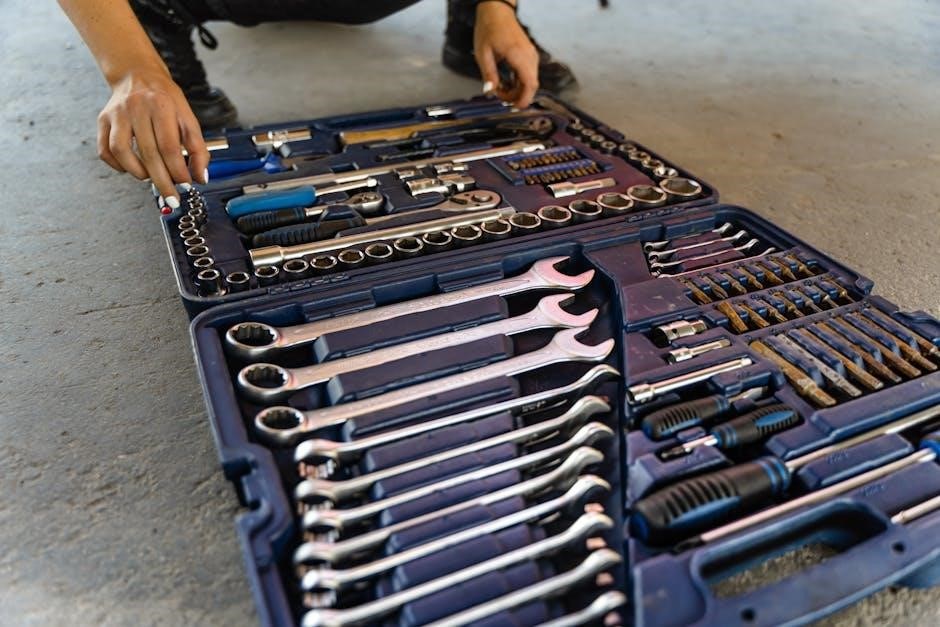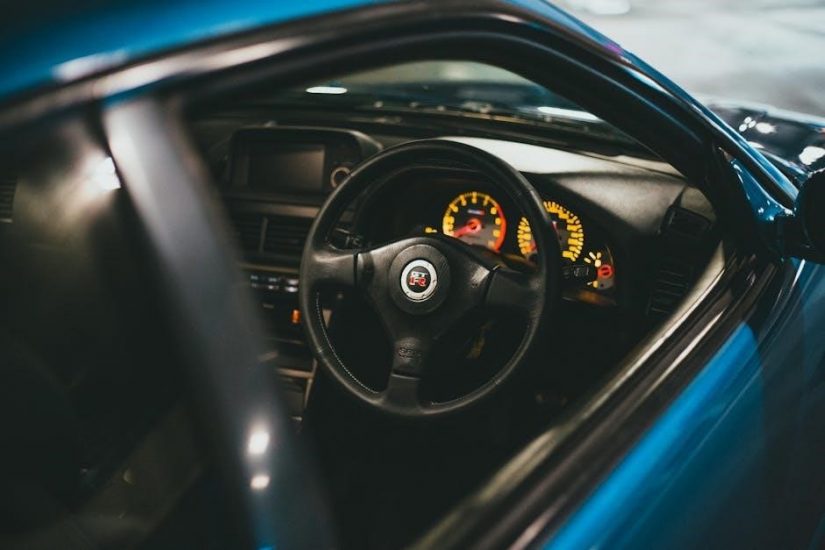Automatic to manual conversion kits enable switching from automatic to manual transmissions, typically including clutch pedal, manual transmission, flywheel, and adapter plate. This complex process requires mechanical expertise and thorough research.
Understanding the Conversion Process
Converting an automatic to a manual transmission involves replacing the automatic system with manual components, requiring mechanical expertise and careful planning to ensure compatibility and functionality.
2.1. Feasibility of Conversion
Converting an automatic transmission to a manual is feasible but requires careful consideration of compatibility and availability of donor parts. Many modern vehicles, especially American models, are not originally equipped with manual transmissions, making the process challenging. A suitable donor car or aftermarket components may be necessary to ensure compatibility with the engine and chassis. The feasibility also depends on the vehicle’s make and model, as some are more practical to convert than others. Researching specific forums or communities can provide insights into whether the conversion is viable for your particular vehicle. Advanced planning and mechanical expertise are essential for a successful swap.
2.2. Benefits of Converting to Manual
Converting to a manual transmission offers several advantages, including improved driver engagement and control. Manual transmissions typically provide better fuel efficiency and lower maintenance costs compared to automatics. Drivers can experience enhanced acceleration and performance, as manuals often allow for more precise gear control. Additionally, manual transmissions are generally lighter and simpler in design, reducing the overall weight of the vehicle. For enthusiasts, the tactile connection of shifting gears manually enhances the driving experience. Furthermore, converting to a manual transmission can increase the vehicle’s resale value, as many drivers prefer the precision and responsiveness of a manual setup. These benefits make the conversion appealing to both practical and performance-oriented drivers.

Key Components Required for Conversion
Key components include a clutch pedal assembly, flywheel, pressure plate, manual transmission, adapter plate, and pilot bearing. These parts ensure proper functionality and compatibility during the swap;
3.1. Clutch Pedal Assembly
The clutch pedal assembly is a critical component for manual transmission conversion, as it enables driver control over gear shifts. This assembly typically includes the pedal, master cylinder, and associated switches. The clutch pedal is entirely new, as automatic vehicles lack this feature. The master cylinder generates hydraulic pressure to engage and disengage the clutch, while switches often control clutch engagement and starter functionality. Proper installation requires modifying the firewall and floorpan to accommodate the pedal and hydraulic lines. Ensuring compatibility with the vehicle’s existing systems is essential for smooth operation. This assembly is indispensable for achieving precise control over the manual transmission.
3.2. Flywheel and Pressure Plate
The flywheel and pressure plate are essential for converting an automatic to a manual transmission. The flywheel must be replaced with one compatible with the manual transmission, often heavier to handle the clutch engagement. The pressure plate works with the clutch disc to disengage power during gear shifts. Installing a new flywheel typically requires resurfacing to ensure proper friction surfaces. The pressure plate must align perfectly with the clutch disc for smooth operation. Proper installation ensures reduced wear and optimal performance. These components are critical for the clutch system to function effectively, making them indispensable in the conversion process.
3.3. Manual Transmission
The manual transmission is the core component in an automatic-to-manual conversion, replacing the automatic transmission entirely. It includes gears, shafts, and bearings designed for manual shifting. compatibility with the vehicle’s engine and drivetrain is crucial for proper function and fitment. The transmission must be sourced from a compatible model or aftermarket supplier, ensuring it matches the engine’s specifications. Installation requires careful alignment with the engine and clutch system. A suitable shifter and linkages must also be installed to complete the system. Proper transmission selection and installation are vital for smooth operation and durability, making it a critical part of the conversion process.
3.4. Adapter Plate
The adapter plate is a critical component that facilitates the connection between the engine and the manual transmission. It ensures proper alignment and compatibility, allowing the manual transmission to bolt up seamlessly to the engine. Adapter plates are typically custom-made or sourced from specialized suppliers to fit specific engine and transmission combinations. They must be precision-engineered to maintain proper gear clearance and alignment. Improper sizing or fitment can lead to vibration, noise, or even transmission failure. The adapter plate is usually installed between the engine block and the manual transmission, requiring careful alignment and torque specification adherence during installation. Its role is essential for a successful conversion, ensuring mechanical integrity and smooth operation.
3.5. Pilot Bearing
The pilot bearing is a small but essential component in an automatic-to-manual conversion, guiding the transmission input shaft during clutch engagement. It is typically located at the end of the input shaft and helps center the clutch disc. A properly functioning pilot bearing ensures smooth operation and prevents damage to the transmission or clutch. In many cases, the original automatic transmission pilot bearing may not be compatible with the manual setup, requiring a replacement specifically designed for the manual transmission. Improper installation or using the wrong pilot bearing can lead to vibrations, noise, or even failure of the clutch system. It is crucial to select the correct pilot bearing for compatibility and performance during the conversion process.
Cost Considerations
Converting an automatic to a manual transmission involves significant costs, including parts like the clutch pedal, flywheel, and manual transmission, as well as labor and tools.
4.1. Cost of Parts
The cost of parts for an automatic to manual conversion can vary significantly. Key components include the clutch pedal assembly, flywheel, pressure plate, manual transmission, adapter plate, and pilot bearing. These parts are essential for the conversion and can range in price depending on the vehicle’s make, model, and the specific transmission being installed. New parts typically cost more than used or refurbished ones, and sourcing components from reputable suppliers is crucial. Additionally, the cost may vary based on whether the transmission is sourced from a donor vehicle or purchased outright. Researching and comparing prices from different suppliers can help in finding the best deals.
4.2. Labor Costs
Labor costs for an automatic to manual conversion can be substantial, as the process is complex and requires specialized mechanical expertise. The cost depends on the mechanic’s experience, workshop rates, and the complexity of the conversion. DIY enthusiasts with advanced mechanical skills can save on labor costs, but professional installation is often recommended due to the intricate nature of the job. Labor costs can range widely, depending on the vehicle and transmission type. Shopping around for quotes from reputable mechanics or transmission specialists is essential to ensure fair pricing. Additionally, labor costs may include fees for diagnostics, alignment, and post-installation tuning to ensure the manual transmission operates smoothly.
4.3. Tools and Equipment Expenses
Tools and equipment expenses are a significant part of the automatic to manual conversion process. Specialized tools, such as flywheel resurfacing tools, transmission jacks, and clutch alignment kits, are often required. Basic tools like wrenches, sockets, and screwdrivers are essential, but advanced tools may need to be purchased or rented. Depending on the complexity of the conversion, additional equipment like a hydraulic press or bearing puller might be necessary. These expenses can add up quickly, especially if the required tools are not already in your arsenal. Budgeting for tools and equipment is crucial to avoid unexpected costs during the conversion process.

DIY vs. Professional Installation
Deciding between a DIY and professional installation for an automatic to manual conversion depends on your mechanical expertise and resources. DIY installations can save money but require extensive knowledge, specialized tools, and time. Professional installation ensures quality and reliability, as experts handle complex tasks like transmission alignment and clutch setup. However, it comes at a higher cost. DIY enthusiasts must be prepared for potential challenges, such as troubleshooting issues or acquiring rare parts. Professionals, on the other hand, often guarantee their work and provide warranty coverage. Assessing your skill level, budget, and access to tools will help determine the best approach for your conversion project.
Necessary Modifications
Converting to a manual transmission often requires modifications to the chassis, electrical systems, and driveshaft to ensure compatibility and proper integration of the new components.
6.1. Chassis Modifications
Chassis modifications are often necessary to accommodate the manual transmission, including changes to transmission mounts, crossmembers, and driveshaft alignment. These adjustments ensure proper fitment and prevent damage. Additional structural reinforcements may be required to support the new components, especially if the original chassis was designed for an automatic transmission. Drilling holes for the clutch pedal or shifter linkage might also be needed, depending on the vehicle. Proper alignment of the driveshaft and axles is critical to maintain drivetrain efficiency and avoid vibrations. These modifications require precise planning and execution to ensure the conversion is successful and reliable.
6.2. Electrical System Adjustments
Converting from automatic to manual transmission often requires electrical system adjustments to ensure compatibility and proper functionality. The biggest change involves reprogramming the Engine Control Module (ECM) to recognize the manual transmission and clutch operation. This ensures the engine management system works seamlessly with the new setup. Additionally, wiring modifications may be needed to install components like the clutch switch, which controls the starter motor and engages the clutch. Some vehicles may also require adjustments to the Reverse Light Circuit to function correctly with the manual transmission. Proper electrical system modifications are essential to avoid drivetrain issues and ensure smooth operation of the vehicle.
6.3. Driveshaft Alterations
Driveshaft alterations are often necessary when converting from an automatic to a manual transmission. This is because the manual transmission typically has different gear ratios, which can affect the driveshaft’s compatibility and overall drivetrain harmony. The driveshaft may need to be shortened or lengthened to properly fit the new manual transmission. Additionally, balancing the driveshaft is crucial to prevent vibrations, especially at higher speeds. If the driveshaft isn’t correctly modified, it can lead to uneven wear on connected components and potentially cause mechanical failure. For optimal performance and safety, it’s essential to ensure the driveshaft is precisely adjusted and balanced for the manual setup.
Challenges and Considerations
Converting an automatic transmission to a manual setup presents several challenges. Compatibility issues between components, such as the flywheel and clutch, must be addressed to ensure smooth operation. Labor costs can be high due to the complexity of the process. Mechanical expertise is essential, as improper installation can lead to drivetrain issues. Additionally, altering the driveshaft and chassis may be required, which adds to the overall difficulty. Vibrations and fitting problems are common if modifications are not done precisely. Research and careful planning are crucial to avoid costly mistakes. Professional assistance is often recommended for those lacking experience in such conversions.
Step-by-Step Conversion Process
Begin with preparation, removing the automatic transmission, followed by installing the manual transmission, clutch, and pedal assembly. Connect electrical systems, bleed the hydraulic lines, and test thoroughly.
8.1. Preparation and Planning
Preparation is crucial for a successful automatic to manual conversion. Start by researching the feasibility of the swap for your specific vehicle, ensuring all necessary parts are available. Gather tools, such as wrenches, sockets, and hydraulic bleed kits. Consult repair manuals or online forums for detailed instructions. Plan the workspace, ensuring it is clean and well-lit. Safety is paramount, so wear protective gear and disconnect the battery. Organize the components and ensure compatibility, such as the correct flywheel and pilot bearing. Create a checklist to track progress and avoid missing steps. Proper planning prevents delays and ensures a smooth transition to manual transmission.
8.2. Removing the Automatic Transmission
Removing the automatic transmission requires careful planning and mechanical aptitude. Start by draining the transmission fluid and disconnecting the battery. Next, disconnect the transmission cooler lines, electrical connectors, and shift linkages. Remove the transmission mounts and crossmember for access. Use a transmission jack to support the unit while removing the mounting bolts. Slowly lift the transmission out of the vehicle, ensuring no damage to surrounding components. Be cautious of the transmission’s weight and fluid residue. Once removed, inspect the area for any remaining parts or debris. Properly dispose of the old transmission and prepare the space for the manual transmission installation. This step is critical for a smooth conversion process.
8.3. Installing the Manual Transmission
Installing the manual transmission is a precise process that requires attention to detail. Begin by positioning the manual transmission under the vehicle, ensuring it aligns with the engine and chassis. Secure the transmission using the adapter plate and mounting hardware. Install the pilot bearing in the center of the transmission input shaft. Reconnect the driveshaft, clutch pedal assembly, and gear shifter, ensuring proper alignment. Tighten all bolts and connections according to the manufacturer’s specifications. Finally, lubricate all moving parts and test the transmission by shifting through the gears manually. Proper installation ensures smooth operation and prevents future mechanical issues.
8.4. Testing and Fine-Tuning
After installing the manual transmission, thorough testing is essential to ensure proper function. Start by checking the clutch pedal engagement and gear shifts for smooth operation. Verify that all gears engage evenly and without grinding. Test the clutch release mechanism to ensure it disengages fully. Perform a test drive in a safe, open area to evaluate acceleration, shifting, and braking. Fine-tune the clutch pedal adjustment and gear shifter alignment if necessary. Inspect for any leaks or unusual noises. Proper testing ensures the conversion is reliable and performs as intended, providing a seamless driving experience.

Importance of Research
Research is crucial when planning an automatic to manual conversion. It helps determine the feasibility of the project, identify required parts, and understand potential challenges. Investigating forums, repair manuals, and expert advice ensures a well-prepared approach. Understanding the specific requirements for your vehicle model, such as compatible transmissions or necessary modifications, is vital. Research also reveals common pitfalls and solutions, saving time and money. Additionally, it helps in sourcing reliable suppliers for conversion kits and components. Thorough research ensures the project is executed safely and effectively, avoiding costly mistakes and ensuring compatibility. Proper planning and knowledge gathering are essential for a successful conversion.

Post-Conversion Driving Tips
After converting to a manual transmission, it’s essential to adapt your driving habits. Start by practicing in a safe, open area to get accustomed to the clutch and gear shifts. Avoid aggressive acceleration and riding the clutch, as this can wear out components. Use the clutch smoothly, pressing it fully when shifting gears. Always downshift before braking to maintain control and reduce wear on the brakes. Be mindful of stopping on inclines and use the handbrake if necessary. Regularly check your driving technique to ensure smooth transitions between gears. Over time, you’ll develop muscle memory, making manual driving second nature.
Maintenance Tips
Regular maintenance is crucial to ensure the longevity of your manual transmission after conversion. Check the clutch fluid level regularly and top it off as needed to maintain proper clutch engagement. Inspect the clutch cable for signs of wear or fraying and replace it immediately if damaged. Monitor the transmission fluid level and change it every 30,000 to 60,000 miles, depending on the manufacturer’s recommendations. Avoid riding the clutch, as this can cause unnecessary wear on the clutch and pressure plate. Inspect the flywheel and pressure plate for excessive wear during clutch replacements. Finally, ensure the drivetrain is properly aligned to prevent uneven stress on the transmission and related components.
Legal and Safety Considerations
When converting an automatic transmission to manual, ensure compliance with local vehicle regulations to avoid legal issues. Verify that the conversion meets emissions and safety standards in your region. Proper installation is critical to prevent mechanical failure, which could lead to accidents. Always follow safety guidelines during the process, such as wearing protective gear and ensuring the vehicle is securely lifted. Improperly installed components can result in sudden failure, posing significant risks. Consult a professional if unsure about any step. Additionally, check local inspection requirements to confirm the conversion is approved. Safety should never be compromised during or after the conversion process.
Myths vs. Reality
Several myths surround automatic to manual transmission conversions. One common misconception is that the process is prohibitively expensive, but in reality, costs can be managed with careful planning and sourcing of parts. Another myth is that the conversion is overly complex and requires extensive mechanical expertise, though many enthusiasts successfully complete the process with basic tools and guidance. Additionally, some believe that modern automatic transmissions are inherently superior, but manual transmissions often offer better control and fuel efficiency. Understanding these myths helps set realistic expectations for those considering a conversion. Research and preparation are key to separating fact from fiction.
Tools and Equipment Needed
Converting an automatic to a manual transmission requires specialized tools and equipment. Essential tools include a transmission jack, wrenches, sockets, and a clutch alignment tool. A flywheel puller and pressure plate bolts are also necessary. Additionally, a drill press and welding equipment may be needed for fabricating parts. Jack stands and a hydraulic jack ensure safety during the process. A multimeter can help with electrical adjustments. Proper tools are crucial for safety and success. Always consult a detailed guide for specific requirements based on your vehicle make and model to ensure you have everything needed before starting the conversion process.
Common Mistakes to Avoid
When converting an automatic transmission to manual, several common mistakes should be avoided. Forgetting to install a pilot bearing can lead to transmission damage. Improper alignment of the manual transmission with the engine can cause drivetrain issues. Neglecting to adjust the clutch pedal assembly correctly may result in poor shifting performance. Ignoring electrical system modifications, such as clutch switch installation, can lead to errors. Using incorrect tools or fasteners can damage components. Additionally, rushing the process without proper planning often results in overlooked steps. Researching and following a detailed guide can help minimize these errors. Professional assistance is recommended for complex tasks to ensure a successful conversion.

Troubleshooting Common Issues
Common issues during an automatic to manual conversion include difficulty shifting gears, which may stem from improper clutch pedal adjustment or hydraulic system leaks. Another issue is the clutch failing to engage, often due to incorrect installation of the master or slave cylinder. Grinding noises during gear shifts can result from improper clutch release or misaligned gears. Electrical problems, such as malfunctioning clutch switches, can prevent proper engagement. Additionally, drivetrain vibrations may arise from incorrect flywheel or pilot bearing installation. Addressing these issues requires careful inspection and adjustment of components. Consulting a detailed repair manual or seeking professional help can resolve these problems effectively.

Long-Term Benefits
Converting to a manual transmission offers several long-term benefits, including improved fuel efficiency and reduced maintenance costs over time. Manual transmissions are generally more durable and require less complex repairs compared to automatics. Drivers also experience better control and engagement with the vehicle, enhancing the overall driving experience. Additionally, manual transmissions often retain higher resale value due to their popularity among enthusiasts. The ability to customize and upgrade components, such as gearing and clutch systems, provides flexibility for performance tuning. Furthermore, mastering manual driving skills can lead to safer and more efficient driving habits. Overall, the conversion proves to be a cost-effective and rewarding investment for drivers seeking a more connected and sustainable driving experience.
Converting an automatic transmission to a manual setup is a rewarding yet challenging project that requires careful planning and execution. While the process demands significant time, effort, and expertise, the long-term benefits, such as improved fuel efficiency, lower maintenance costs, and enhanced driving control, make it a worthwhile investment for enthusiasts. Proper research, preparation, and adherence to best practices are crucial to ensure a successful conversion. For those willing to embrace the complexity, the satisfaction of driving a manually shifted vehicle is unmatched. Ultimately, this project is ideal for DIY enthusiasts seeking a hands-on experience and a deeper connection with their vehicle.
